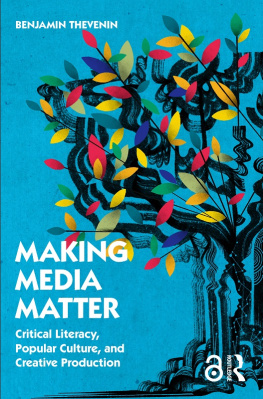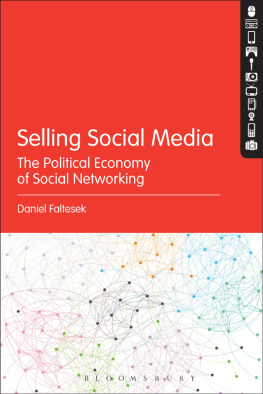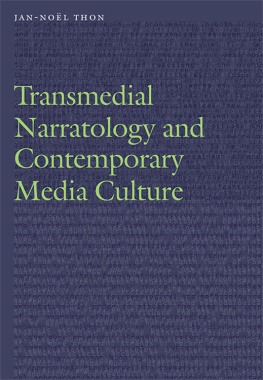Thank you for buying this ebook, published by NYU Press.
Sign up for our e-newsletters to receive information about forthcoming books, special discounts, and more!
Sign Up!
About NYU Press
A publisher of original scholarship since its founding in 1916, New York University Press Produces more than 100 new books each year, with a backlist of 3,000 titles in print. Working across the humanities and social sciences, NYU Press has award-winning lists in sociology, law, cultural and American studies, religion, American history, anthropology, politics, criminology, media and communication, literary studies, and psychology.
MEDIA FRANCHISING
POSTMILLENNIAL POP
General Editors: Karen Tongson and Henry Jenkins
Puro Arte: Filipinos on the Stages of Empire Lucy Mae San Pablo Burns
Spreadable Media: Creating Value and Meaning in a Networked Culture Henry Jenkins, Sam Ford, and Joshua Green
Media Franchising: Creative License and Collaboration in the Culture Industries Derek Johnson
Your Ad Here: The Cool Sell of Guerrilla Marketing Michael Serazio
NEW YORK UNIVERSITY PRESS
New York and London
www.nyupress.org
2013 by New York University
All rights reserved
References to Internet Websites (URLs) were accurate at the time of writing. Neither the author nor New York University Press is responsible for URLs that may have expired or changed since the manuscript was prepared.
Library of Congress Cataloging-in-Publication Data
Johnson, Derek, 1979
Media franchising : creative license and collaboration in the culture industries / Derek Johnson.
pages cm
Includes bibliographical references and index.
ISBN 978-0-8147-4347-8 (hbk. : alk. paper) ISBN 978-0-8147-4348-5
(pbk : alk. paper) ISBN 978-0-8147-4349-2 (ebk.)
ISBN 978-0-8147-4389-8 (ebk.)
1. Cultural industries. 2. Franchises (Retail trade) I. Title.
HD9999.C9472J64 2013
658.8708dc23 2012040758
New York University Press books are printed on acid-free paper, and their binding materials are chosen for strength and durability. We strive to use environmentally responsible suppliers and materials to the greatest extent possible in publishing our books.
Manufactured in the United States of America
c 10 9 8 7 6 5 4 3 2 1
p 10 9 8 7 6 5 4 3 2 1
Acknowledgments
Like the media franchising it explores, the production of this book was an ongoing, iterative process spanning many years in which multiple collaborators contributed across different sites and communities of inquiry, scholarly in this case instead of industrial. Though I may claim authorship (and NYU Press ownership), many other stakeholders should claim this work as well.
I am indebted to Michael Curtin, Mary Beltrn, Jeff Smith, Nan Enstad, Julie DAcci, and especially my advisor Michele Hilmes, who helped set me on this course and guided my PhD research at the University of Wisconsin from 2006 to 2009. Lisa Nakamura, Shanti Kumar, and David Bordwell served as key influences and supporters too. As I continued to develop that research into this book, I depended heavily on the generous advice and good friendship of Jonathan Gray, who was somehow never too busy to share his thoughts long distance. Denise Mann has been a strong advocate for the project, while the manuscript also benefited from the thoughtful comments of Barbara Selznick as well as a number of anonymous reviewers. My friend and colleague Aswin Punathambekar also offered invaluable comments. NYU Press provided an incredibly nurturing environment for this collaborative process, thanks to supportive direction by Eric Zinner and Ciara McLaughlin. Although I joined their series later on, the contributions of series editors Karen Tongson and Henry Jenkins were no less significant, particularly in helping me stand behind my claims with conviction. Henry has long acted as a champion for my workeven and perhaps especially when it has challenged hisso it seems appropriate that my gratitude to him would continue here.
Many of the ideas in this book also benefited from having been previously worked through or expanded upon in other publications whose editors also deserve my thanks. Portions of profited from the opportunity I had to engage in an expanded exploration of those issues as Devaluing and Revaluing Seriality in Media, Culture & Society 33.7 (2011).
Numerous other colleagues, students, and friends contributed to this project either through direct support or just good conversation, including Megan Ankerson, Ivan Askwith, Ben Aslinger, Laurie Baird, Nancy Baym, Colin Burnett, Kristina Busse, Norma Coates, Gail de Koznik, Sam Ford, Joshua Green, Sean Griffin, Germaine Halegoua, Lee Harrington, Lindsay Hogan, Kit Hughes, Josh Jackson, Derek Kompare, Shanti Kumar, Elana Levine, Geoffrey Long, Amanda Lotz, Myles McNutt, Jason Mittell, Maurcio Mota, Sarah Murray, Daniel Pereira, Chris Russell, Kevin Sandler, Avi Santo, Suzanne Scott, Erin Copple Smith, Louisa Stein, Serra Tinic, and Shawn Vancour. Evan Elkinss eagle eye was particularly helpful. Having returned to UWMadison, I am also grateful for the support of my colleagues in the Communication Arts department and across campus, especially the feedback of Jeremy Morris and the guidance of my faculty mentor Rob Howard. Harry Benshoff deserves special mention as my previous mentor at the University of North Texas. The Convergence Culture Consortium at MIT (and later, the Futures of Entertainment group) also provided institutional support as well as plentiful opportunities to workshop my ideas. Equal thanks go out to the search committees that hosted me for job talks and allowed me to share works in progress. My archival research would not have been possible without the help of Ned Comstock at the USC Cinematic Arts Library and Lauren Buisson at the UCLA Arts Special Collections Library, or the repeated hospitality of my friends Scott Gillies and Holly Brobst. My gratitude also goes out to Danny Bilson, Flint Dille, Kelly Kahl, Hassan Kazmi, Justin Lambros, Bear McCreary, Marti Noxon, Brian Raffel, Ed Skolarus, Jim Tso, Dan Vondrak, Mark Warshaw, and all the anonymous industry professionals who took time out of their busy days to chat with me. As my research assistants at the University of North Texas, Aaron Martin and Dave Hartwell made helpful contributions too. A subvention for this book was also awarded through a competitive grant from the University of WisconsinMadison Provosts Office and the Graduate School. Graduate School funding has been provided by the Wisconsin Alumni Research Foundation (WARF) with income generated by patents filed through WARF by UWMadison faculty and staff.
The most important contributor, however, has been my wife Colleen. I wish I could say that I have been as supportive of her pursuits as she has been of mine, but since she has set the bar impossibly high, I hope my love for her can cover the difference somehow. A book dedication might also help, but unfortunately that honor goes to someone elseour clever, funny, and beautiful daughter Dahlia. Having finished the book, I hope I have not just freed up more quality time for all three of us, but also written something that will one day make Dahlia half as proud of me as I already am of her.









